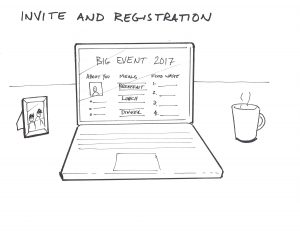Prevent Waste By Planning
Food waste prevention is a critical part of how everyday work is done.
Preventing food waste should be top priority. Not only will it save your property money, but it will also save valuable resources from being wasted, such as water needed to produce crops, energy for the growth and transport of food, and natural habitat that is converted for agriculture.
Let’s look at helpful tips to prevent waste along the “flow of food” during the following phases:
PLAN | HANDLE | SERVE
Planning
Preventing waste takes thoughtful planning by several task force roles to accomplish the major activities.
Below find guiding principles for each activity.
Event Sales | Contracts | Data Use | Sourcing | Menus
Event Sales
- Communicate waste reduction efforts to clients and guests.
- Discuss reduction strategies in banquet event order (BEO) meetings. Get Talking Points.
- Promote plated meals or buffets with stations as an alternative to a traditional buffet.
 Include menu of the day or low waste menu options in event menu portfolio.
Include menu of the day or low waste menu options in event menu portfolio.- Customize menus for attendees using historic or supplied food preference data.
Event Contracts
- Include food waste reduction and food recovery strategy in event contracts.
- Include a final set time for buffets in contracts and BEOs.
- Require updated guest counts 10 and 5 days prior to the event, and day of.
- Add donation partner agreements into event contracts so all agree where food will go after event.
- Decrease overage guarantee.
- Include an overage menu for unexpected attendance instead of a percentage of overproduction on each dish.
Data Use
- Ensure accurate guest counts through frequent communication with planners.
- Use technology solutions or email to communicate last minute changes in attendance to culinary staff.
- Use historic or provided consumption or food preference data to inform procurement decisions.
- Use Meal RSVP software to guide production.
- Communicate food waste data to client post-event.
Sourcing

- Work with suppliers that limit waste.
- Change the aesthetic and order from suppliers that stock “seconds” or “ugly” produce. These are just as fresh and often cheaper.
- Check inventory before ordering to prevent spoilage.
- Evaluate ingredients for alternative sourcing methods to reduce spoilage or prep waste, such as frozen or pre-prepped.
- Adjust standing orders based on business volume to reduce possibility of spoilage.
Waste Reducing Menus
- Use low waste ingredients.
- Feature “seconds” or “ugly” produce in recipes.

- Limit dessert portions, especially during lunches.
- Reduce the total number of ingredients you use by cross-utilizing in multiple recipes.
- Plan a second use for all edible prep waste.
- Reduce food weight produced per cover. Most guests consume about 1.2 lbs. of food per meal.
- Prepare overage a la minute or develop a menu of the day or overage menu that can be used across events for unexpected attendance.
- Include reduced waste menu in event portfolio.


